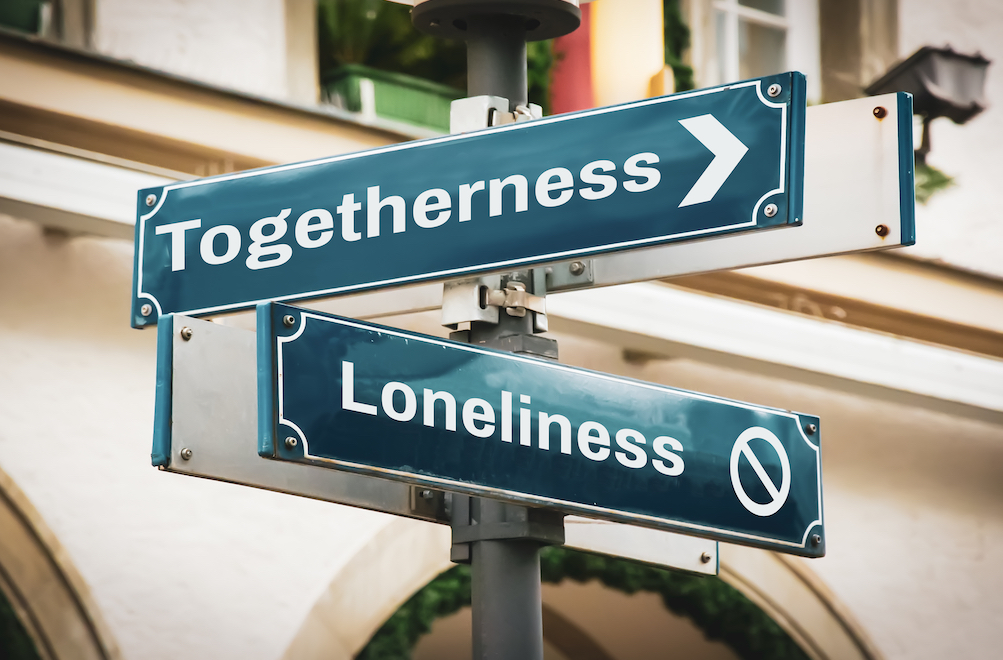
Social interactions are considered a basic human need, very similar to other needs such as eating or sleeping. When these needs are not met, and our fulfillment from social contact falls short we may experience loneliness. Research suggests that between 10 and 36% of individuals experience loneliness at some point in their lives (Beutel et al., 2017; Richard et al., 2017). The Covid-19 pandemic certainly had an impact on loneliness with cross-sectional evidence showing that 35% of over 15,000 individuals reported feeling lonely during the first lockdown (Li & Wang, 2020). Loneliness can have a damaging impact on mental health and well-being as it may increase the risk of depression and anxiety (Loades et al., 2020), or worse, self-harm and suicide (McClelland et al., 2020; Beutel et al., 2017).
This paper specifically uses the Integrated Motivational-Volitional (IMV) model to explain the role of loneliness in self-injury. In simple terms, the IMV model explains the risk of suicide using three phases: the pre-motivational phase, the motivational phase and the volitional phase (O’Connor & Kirtley, 2018). The pre-motivational phase describes a period where risk factors including exposure to early life stressors contribute to the development of suicidal ideation. The motivational phase describes a person’s current psychological state, which as the authors state, may explain how poor coping leads someone to feel defeated, trapped and experience suicidal thoughts. The volitional phase describes the period where suicidal thoughts then turn into actions or behaviours. This 2018 blog by Alexandra Pitman and Lisa Marzano provides a brief overview of the IMV model, and Rory O’Connor’s 2021 book – When It Is Darkest – provides the more detailed and fascinating story behind the development of the model.
In this study, McClelland and colleagues (2021) aim to explore the role of loneliness in distinguishing between individuals with a history of self-injurious thoughts, self-injurious behaviours and no history of self-injury, even after controlling for multiple psychological factors. To examine whether loneliness is a motivational moderator or one that influences how a person’s current feelings turn into suicidal thoughts, the authors also examine whether loneliness moderates the relationships between a) defeat and entrapment and b) entrapment and suicidal ideation.

This paper uses the Integrated Motivational-Volitional (IMV) model to explain the role of loneliness as a motivational moderator in self-injury.
Methods
This study employed a cross-sectional design and opportunistic sampling of adults in the UK. Participants were recruited through social media and invited to complete an online survey between September 2018 and April 2019. The measures in the survey included items on the history of self-injurious thoughts and behaviours, loneliness, suicidal ideation, stress, childhood trauma, socially prescribed perfectionism, autobiographical memory, defeat, entrapment, coping and social support. Participants were classified as having a history of:
- No self-injury (NH)
- Self-injurious thoughts only (SIT)
- Self-injurious behaviours regardless of thoughts (SIB).
Data were analysed using univariate and multivariate logistic regressions (to account for the influence of other psychological variables) and pairwise comparisons. Simple slopes were used to test moderator effects. Missing data were handled using Estimation-Maximisation imputation techniques.
Results
400 participants took part in the study. Most participants were female, on average 35 years old, of British nationality and employed.
Suicidal ideation and loneliness were significantly associated with all but two variables related to memory. Results from the multivariate analysis revealed that loneliness differed between all groups. Further analysis using pairwise comparisons to determine which specific groups differed, revealed that loneliness scores only differed between individuals with no history of self-injury and individuals with a history of self-injurious thoughts only (OR = 1.089), over and above other psychological factors. However, loneliness did not differ between individuals with no history of self-injury and self-injurious behaviours or between a history of self-injurious thoughts and self-injurious behaviours only.
Moderation analyses revealed that loneliness was a statistically significant moderator between defeat and entrapment, even in those who presented with low or no loneliness. Loneliness was also a significant moderator between entrapment and suicidal ideation. The moderation model showed that higher levels of entrapment and loneliness were associated with higher levels of suicidal ideation. Conversely, those who reported the lowest levels of suicidal ideation reported low levels of entrapment and low levels of loneliness.

Loneliness only distinguished between individuals with no history of self-injury and history of self-injurious thoughts only, over and above other psychological factors.
Conclusions
The authors provide convincing evidence that loneliness indeed may function as a motivational moderator in the context of the IMV. They stated:
This study suggests that loneliness distinguishes between those with and without a history of self-injurious thoughts. Within the context of the IMV model, loneliness was found to moderate both the defeat of entrapment and the entrapment to self-injurious thoughts relationships.

This study highlights the importance of loneliness in the emergence of self-injurious thoughts.
Strengths and limitations
Overall, the study had clear aims and hypotheses, a wide range of validated and reliable measures, and an appropriate analysis plan including handling of missing data. The authors acknowledged that the scope of their work only involved constructs from the IMV model, which they described in great detail. One of the biggest strengths was that the researchers controlled for a wide range of psychological factors including cognitive, clinical, personality, social support, and coping measures in their analysis.
McClelland and colleagues identified key limitations in their study. Notably, they did not consider the duration and severity of suicidal ideation in their groupings which could have a significant influence on main and interaction effects. The authors’ main recommendation is that loneliness and self-injurious thoughts and behaviour “be explored longitudinally in tandem with other psychological factors (e.g., depression)”. Indeed, this limitation is a crucial next step to understanding whether there are any mediation effects or causal associations and determining the risk of loneliness on mental health over the life course. The authors also identified their sampling strategy as a limitation, which resulted in a relatively homogeneous sample and doubts on whether the findings can be generalised. Future research must consider targeting less represented areas in recruitment to avoid this problem.
It would have been interesting for the authors to examine age differences, as research suggests that both loneliness and self-harm are more prevalent in younger age groups (Luhmann & Hawkley, 2016; Hawton et al., 2007), and integrate depression and anxiety scales into their measures. Furthermore, to strengthen their argument of loneliness acting solely as a motivational moderator, the authors could have examined its role as a volitional moderator (e.g. moderating the relationship between suicidal ideation and suicidal behaviours). Lastly, while we acknowledge the exploratory nature of this study, hypothesis and data analysis plans should have been pre-registered.

A strength of this study included analysis controlling for a range of psychological factors while a cross-sectional design and lack of diversity were limitations of this study.
Implications for practice
This paper contributes important insights for clinical practice:
- First and foremost, loneliness can be managed with interventions. A systematic review and meta-analysis found that psychological interventions for loneliness are effective (Hickin et al., 2020). Typically, these interventions include cognitive behavioural therapy, reminiscence therapy, or social support interventions.
- There has been an increase in the diversity of therapeutic approaches for self-injury in recent years, therefore incorporating evidence on known moderators such as loneliness is important as it can help determine what treatment is most effective for certain individuals.
- This study is an example of how theoretical frameworks and clinical practice can be combined to distinguish between people experiencing suicidal ideation and incorporate this into evidence-based practice. This can help clinicians determine:
- whether someone might be at a greater or lesser risk of serious injury, and
- what factors can be targeted using a tailored treatment.

Incorporating evidence on known moderators such as loneliness can help determine what treatment approach is most effective for certain individuals.
Statement of interests
No conflicts of interest.
Links
Primary paper
McClelland, H., Evans, J. J., & O’Connor, R. C. (2021). Exploring the role of loneliness in relation to self-injurious thoughts and behaviour in the context of the integrated motivational-volitional model. Journal of Psychiatric Research, 141, 309–317. https://doi.org/10.1016/j.jpsychires.2021.07.020
Other references
Beutel, M.E., Klein, E.M., Brähler, E. et al. (2017). Loneliness in the general population: prevalence, determinants and relations to mental health. BMC Psychiatry 17, 97. https://doi.org/10.1186/s12888-017-1262-x
Hawton, K., Bergen, H., Casey, D. et al. (2007). Self-harm in England: a tale of three cities. Social Psychiatric Epidemiology, 42, 513–521. https://doi.org/10.1007/s00127-007-0199-7
Hickin N, Käll A, Shafran R., et al., (2018). The effectiveness of psychological interventions for loneliness: A systematic review and meta-analysis, Clinical Psychology Review, 88, 102066. https://doi.org/10.1016/j.cpr.2021.102066
Li LZ, Wang S. (2020). Prevalence and predictors of general psychiatric disorders and loneliness during COVID-19 in the United Kingdom. Psychiatry Research, 291:113267. https://doi.org/10.1016/j.psychres.2020.113267
Loades ME, Chatburn E, Higson-Sweeney N, et al. (2020). Rapid Systematic Review: The Impact of Social Isolation and Loneliness on the Mental Health of Children and Adolescents in the Context of COVID-19. J Am Acad Child Adolesc Psychiatry, 59(11):1218-1239.e3. https://doi.org/10.1016/j.jaac.2020.05.009
Luhmann M, Hawkley LC. (2016). Age Differences in Loneliness From Late Adolescence to Oldest Old Age. Developmental Psychology, 62(6):943–59. https://doi.org/10.1037/dev0000117
McClelland, H., Evans, J.J., Nowland, R., Ferguson, E., O’Connor, R.C,. (2020). Loneliness as a predictor of suicidal ideation and behaviour: a systematic review and metaanalysis of prospective studies. Journal of Affective Disorders. 274, 880–896. https://doi.org/10.1016/j.jad.2020.05.004
O’Connor, R. C., & Kirtley, O. J. (2018). The integrated motivational-volitional model of suicidal behaviour. Philosophical transactions of the Royal Society of London, Series B, Biological sciences, 373(1754), 20170268. https://doi.org/10.1098/rstb.2017.0268
Richard A, Rohrmann S, Vandeleur CL, Schmid M, Barth J, Eichholzer M (2017) Loneliness is adversely associated with physical and mental health and lifestyle factors: Results from a Swiss national survey. PLoS ONE, 12(7): e0181442. https://doi.org/10.1371/journal.pone.0181442
Photo credits
- Photo by Todd Trapani on Unsplash
- Photo by Ameen Fahmy on Unsplash
- Photo by Nijwam Swargiary on Unsplash
- Photo by Omar Ram on Unsplash
